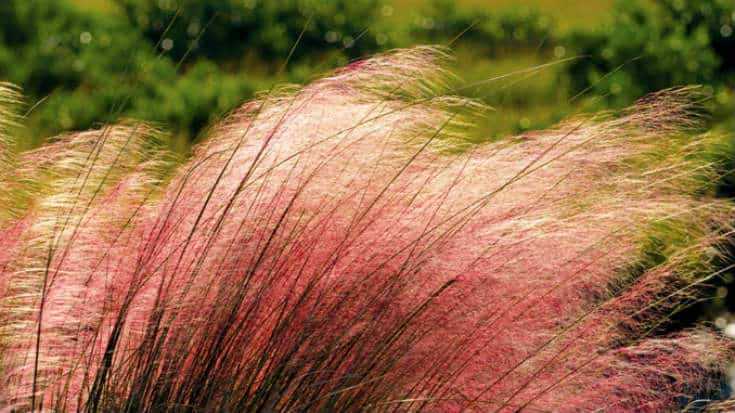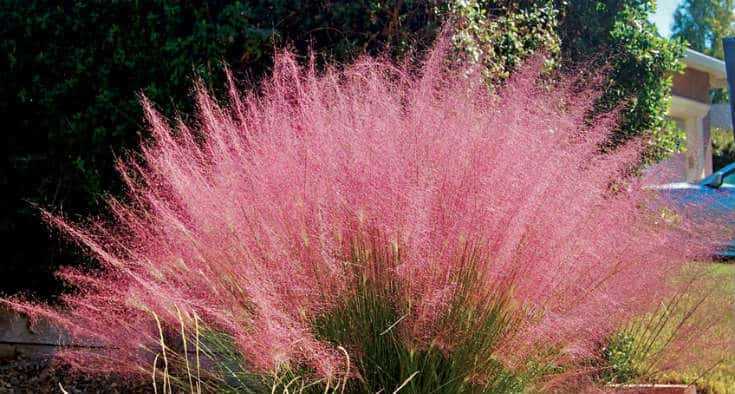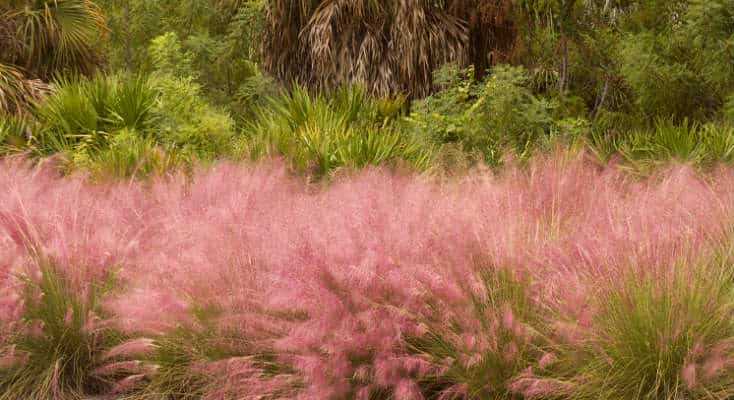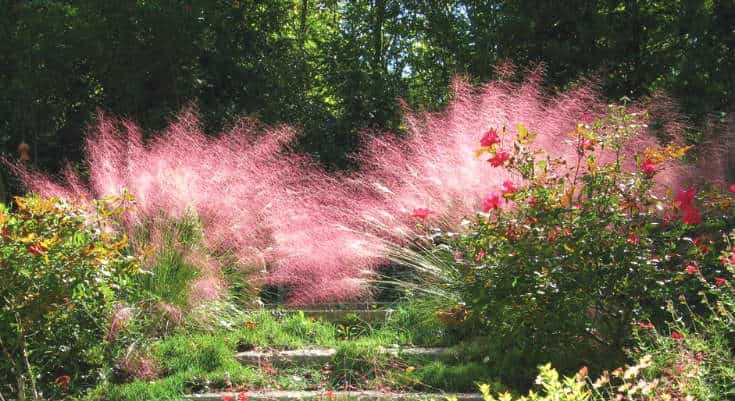Pink Muhly Grass - Muhlenbergia Capillaris

When searching for the perfect bloom that brings both color and whimsy to the garden, consider a plume bloom! Muhlenbergia Capillaris, commonly known as Pink Muhly Grass, is an ornamental perennial grass famous for wispy, pink plumes peeking above dense, green foliage, adding an unexpected flair to landscaped beds.
Do not be deceived by its delicate appearance, though. Pink Muhly Grass mounds are quite hardy, requiring little maintenance or extra watering.
They can grow almost anywhere in the U.S., stay green throughout the winter, and bloom each fall.
Let’s look at Pink Muhly Grass and how to incorporate it into the garden.
Pink Muhly Grass Key Facts
| Fact Sheet | |||
|---|---|---|---|
| Plant Type | Grasses | Flower Color | Pink |
| Plant Height | 4 ft | Flowering Season | Summer to Fall |
| Plant Width | 4 ft | Dormancy | Evergreen |
| Growth Rate | Fast | Water Requirement | Low |
Pink Muhly Grass is native to the North American Continent, particularly California and the eastern United States. It is a fast-growing plant, reaching a maturation height of four feet in just a couple of seasons, and its thick foliage can reach three feet in width.
Blue-green blades will brighten in the spring, with its notorious pink plumes debuting in late summer or early fall.
Pink Muhly Grass likes plenty of sunshine and thrives in areas that receive partial to full sunlight. It can grow in nearly any type of soil that is well-drained and can even withstand moderate droughts.
Every 2 to 3 years, the plants can be divided and shared with other areas of the garden.

Caring for Pink Muhly Grass
When to plant Pink Muhly Grass?
Pink Muhly Grass is a relatively low maintenance ornamental grass that anyone can maintain. It is best to plant Muhlenbergia Capillaris in the spring. As the seasons progress into summer, the blue-green mound of grassy foliage will begin to take shape and spread out over 2 feet in diameter.
The feathery, pink blooms will make their dramatic debut by early fall just when most other flowers are beginning to fade away.
Where to plant Muhlenbergia Capillaris?
Pink Muhly Grass thrives in zones 5-9. As far north as New England and as far south as Florida, Pink Muhly can flourish and brighten almost any landscape.
When to water
Ideally, the plants will receive a weekly rainfall, but mature plants do not require extra watering unless they have experienced a particularly dry season.
For baby Pink Muhly Grasses and newly transplanted mounds, be sure to give them several good drinks of water for the first few weeks while their roots get established.
Soil
Pink Muhly Grass can naturally grow in rocky soil, forests, or on coastal dunes. It is not picky about where it takes root.
For best results, though, make sure that the soil is well-drained and that the grass mound will not have to sit in standing water.
Pruning the Pink Muhly
Pink Muhly Grass is considered an evergreen, but there may be some grass blades that turn brown over the winter months. Cut these dead blades off in early spring with scissors or small pruning shears.
Other than that, they do not require regular trimming unless the gardener wishes to give them a new shape.
Division
Another appealing aspect of these hardy perennials is that they can be divided once they are mature. Every 2 to 3 years, gently pull up the plant mound and divide the root ball into two pieces.
Be sure to include plenty of green foliage on each half of the divided plant. Transplant the divided pieces into well-drained soil in an area that gets plenty of sunshine.
Give the new transplant several good drinks of water over the first few days, and anytime it experiences a dry spell over the next few weeks.
Planting and Cultivating Young Pink Muhly Plants
It is always a good idea to add fertilizer or compost to soil before planting. If using a pre-packaged fertilizer, look for one with an NPK (Nitrogen, Phosphorus, Potassium) ration of 10-10-10.
Spread the fertilizer evenly over the ground and work it into the dirt. Cultivate the fertilized soil 8 to 10 inches deep with a tiller, spade, or garden hoe.
Dig a hole deep enough to cover the root ball and place the young or newly divided muhly grass inside.
Make sure that the plant’s crown – the bottom of the plant where the grass emerges from the roots – is slightly above the rest of the soil. Once the plant is in the hole, fill it with water to give the roots a good drink and jumpstart growth.
Once the root ball has absorbed the water, fill in the hole with soil.
Throughout its first growing season – especially in the first few weeks – water the muhly grass frequently enough to keep the soil moist, but not soggy.
Remember, muhly grasses appreciate water but must have well-drained soil.
At the end of its first growing season, the muhly grass will be mature and well established, so it will not require any extra watering unless it has experienced a particularly dry and hot season.

Where to Buy Pink Muhly Grass
Pink Muhly Grass is not only easy to grow, it’s also easy to find. Local nurseries or the lawn and garden section of many major retailers will have them available in the spring and summer.
They can also be ordered online and delivered to the front door, ready to plant.
Wayside Gardens offers baby Pink Muhly Grass in a 1-quart container for just $8.95, but if purchased in sets or 3 or more, each grass plant is discounted.

Other Ornamental Grasses
Ornamental grasses are easy to grow and can add height, movement, and contrast to simple landscape designs. Typically, ornamental grasses refer to any grass plant that grows in dense mounds of upright blades with tips that billow outward in shades of deep green.
There are a wide variety of grasses, however, and many of them differ dramatically in shape, size, and blooms.
Before choosing the right ornamental grass, consider where it will be planted. How big does this plant get? Will it be near a walkway? Will other plants or structures be within a couple of feet? How many hours of sunlight does the site average each day?
A muhly grass that grows three feet tall and two feet wide may not be the best option for lining a narrow sidewalk.
A shady site on the northern side of a house may not be the best place to try to grow a large, full muhly grass mound because of lack of sunshine.
Consider the differing sizes of muhly grass varieties before purchasing young grasses to plant.
Muhly Grass Variations for Landscaping
Here are some of our favorite muhly grass varieties that can give any landscaped area a professional look:
- Pampas Grasses
- ‘Gracillimus’ Maiden Grass
- Little Bluestem
- Small Fountain Grass
- Blue Oat Grass
Muhly grasses also feature different colored plumes designed to dazzle.
Pink Muhly Grass Alternatives
Consider some of these alternatives to the Pink Muhly Grass:
- Ruby Muhly Grass
- Purple Muhly Grass
- White Cloud Muhly Grass
- Deer Grass
Conclusion
A professional-looking landscape does not always require a professional landscaper. Muhly grass varieties are a great way to add contrast and bring an element of whim and interest to a yard or garden. Consider adding muhly grass to the spring planting list and enjoy bright, feathery plumes into the fall!
